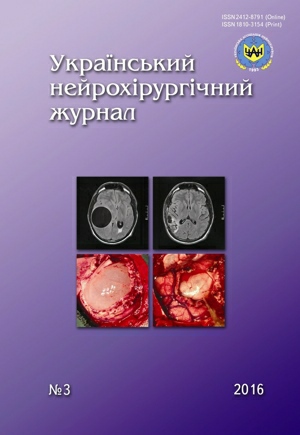Experience of chronic electrical stimulation application for pain management in thoracic outlet syndrome
DOI:
https://doi.org/10.25305/unj.78773Keywords:
thoracic outlet syndrome, pain syndrome, chronic electrical stimulationAbstract
Introduction. Pain is the only common symptom in thoracic outlet syndrome. Ensuring a stable analgesic effect remains challenging today.
The aim of the study was to evaluate the efficacy of pain relief in thoracic outlet syndrome by continuous electrical stimulation, application.
Materials and methods. Results of surgical treatment of 21 patients with thoracic outlet syndrome were analysed. The main clinical symptom in those patients was pain. The intensity of pain was evaluated by a standard visual analog scale. All patients underwent standard surgical techniques with the classic anterior approach including neurolysis of the brachial plexus structures, angiolysis of subclavian vessels, scalenotomy of the supraclavicular area, resection of the extra cervical rib (if necessary) and additional implantation of electrical stimulating system (ESS) “NeySi-3M” (SPE “WEL”, Ukraine) for continuous electrical stimulation of the brachial plexus in the postoperative period.
Results. Regression of pain was observed in 95.2% of patients.
Conclusions. Chronic electrical stimulation of the brachial plexus allows achieving a stable and safe analgesic effect in thoracic outlet syndrome.
References
1. McGillicuddy JE. Thoracic outlet syndrome. In: Chung KC, Yang LJ, McGillicuddy JE, editors. Practical Management of Pediatric and Adult Brachial Plexus Palsies. Edinburgh: Saunders/Elsevier; 2012:318-36.
2. Meyer R, Jones KJ. Thoracic outlet compression syndrome. In: Wolfe SW, editor. Green’s operative hand surgery. Philadelphia: Elsevier/Churchill Livingstone; 2011:1015–34.
3. Aljabri B, Al-Omran M. Surgical management of vascular thoracic outlet syndrome: a teaching hospital experience. Ann Vasc Dis. 2013;6(1):74-9. [CrossRef] [PubMed]
4. Hooper TL, Denton J, McGalliard MK, Brismйe JM, Sizer PS Jr. Thoracic outlet syndrome: a controversial clinical condition. Part 1: anatomy, and clinical examination/diagnosis. J Man Manip Ther. 2010 Jun;18(2):74-83. [CrossRef] [PubMed]
5. Watson LA, Pizzari T, Balster S. Thoracic outlet syndrome part 2: conservative management of thoracic outlet. Man Ther. 2010 Aug;15(4):305-14. [CrossRef] [PubMed]
6. Christo PJ, McGreevy K. Updated perspectives on neurogenic thoracic outlet syndrome. Curr Pain Headache Rep. 2011 Feb;15(1):14-21. Curr Pain Headache Rep. 2011 Apr;15(2):85-7. [CrossRef] [PubMed]
7. Coote H. Exostosis of the left transverse process of the seventh cervical vertebra, surrounded by bloodvessels and nerves; successful removal. Lancet. 1861;77(1963):360-61. [CrossRef]
8. Nichols HM. Anatomic structures of the thoracic outlet. Clin Orthop Relat Res. 1967;51:17-25. [PubMed]
9. Melzack R, Wall PD. Pain mechanisms: a new theory. Science. 1965;150(3699):971-9. [CrossRef] [PubMed]
10. Huskisson EC. Measurement of pain. J Rheumatol. 1982;9(5):768-9. [PubMed]
Downloads
Published
How to Cite
Issue
Section
License
Copyright (c) 2016 Vitaliy Tsymbaliuk, Ihor Tretyak, Boris Luzan, Hao Jiang

This work is licensed under a Creative Commons Attribution 4.0 International License.
Ukrainian Neurosurgical Journal abides by the CREATIVE COMMONS copyright rights and permissions for open access journals.
Authors, who are published in this Journal, agree to the following conditions:
1. The authors reserve the right to authorship of the work and pass the first publication right of this work to the Journal under the terms of Creative Commons Attribution License, which allows others to freely distribute the published research with the obligatory reference to the authors of the original work and the first publication of the work in this Journal.
2. The authors have the right to conclude separate supplement agreements that relate to non-exclusive work distribution in the form of which it has been published by the Journal (for example, to upload the work to the online storage of the Journal or publish it as part of a monograph), provided that the reference to the first publication of the work in this Journal is included.









